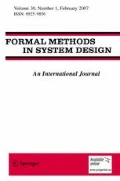Abstract
Runtime verification is aimed at analyzing execution traces stemming from a running program or system. The traditional purpose is to detect the lack of conformance with respect to a formal specification. Numerous efforts in the field have focused on monitoring parametric specifications, where events carry data, and formulas can refer to such. Since a monitor for such specifications has to store observed data, the challenge is to have an efficient representation and manipulation of Boolean operators, quantification, and lookup of data. The fundamental problem is that the actual values of the data are not necessarily bounded or provided in advance. In this work we explore the use of binary decision diagrams for representing observed data. Our experiments show a substantial improvement in performance compared to related work.






Similar content being viewed by others
Notes
DejaVu is available at https://github.com/havelund/dejavu.
\(\upgamma \, [ x \mapsto a ]\) is the overriding of \(\upgamma \) with the binding \([ x \mapsto a ]\).
This restriction from the theory and algorithm presented above is made because our experience shows that this is by far the most common case.
Traces accepted by the tool are concretely in CSV format. For example the first event is a single line of the form: open,input,read.
References
Allan C, Avgustinov P, Christensen AS, Hendren LJ, Kuzins S, Lhotak O, de Moor O, Sereni D, Sittampalam G, Tibble J (2005) Adding trace matching with free variables to AspectJ. In: OOPSLA, pp 345–364
Alpern B, Schneider FB (1987) Recognizing safety and liveness. Distrib Comput 2(3):117–126
Barringer H, Goldberg A, Havelund K, Sen K (2004) Rule-based runtime verification, VMCAI, LNCS Volume 2937. Springer
Barringer H, Havelund K (2011) TraceContract: a scala DSL for trace analysis. In: Proceedings of the 17th international symposium on formal methods (FM’11), LNCS volume 6664. Springer
Barringer H, Rydeheard D, Havelund K (2007) Rule systems for run-time monitoring: from Eagle to RuleR. In: Proceedings of the 7th international workshop on runtime verification (RV’07), LNCS volume 4839. Springer
Basin DA, Klaedtke F, Müller S, Zalinescu E (2015) Monitoring metric first-order temporal properties. J ACM 62(2):45
Bensalem S, Havelund K (2006) Dynamic deadlock analysis of multi-threaded programs. In: Haifa verification conference, Haifa, Israel, LNCS volume 3875. Springer
Bryant RE (1991) On the complexity of VLSI implementations and graph representations of Boolean functions with application to integer multiplication. IEEE Trans Comput 40(2):205–213
Bryant RE (1992) Symbolic Boolean manipulation with ordered binary-decision diagrams. ACM Comput Surv 24(3):293–318
Burch JR, Clarke EM, McMillan KL, Dill DL, Hwang LJ (1990) Symbolic model checking: \(10^{20}\) states and beyond. In: Proceedings. Fifth Annual IEEE Symposium on Logic in Computer Science, pp. 428–439. https://doi.org/10.1109/LICS.1990.113767
D’Angelo B, Sankaranarayanan S, Sánchez C, Robinson W, Finkbeiner B, Sipma HB, Mehrotra S, Manna Z (2005) LOLA: runtime monitoring of synchronous systems. In: TIME, pp 166–174
Decker N, Leucker M, Thoma D (2016) Monitoring modulo theories. J Softw Tools Technol Transf 18(2):205–225
Goubault-Larrecq J, Olivain J (2008) A Smell of ORCHIDS. In: Proceedings of the 8th international workshop on runtime verification (RV’08), LNCS volume 5289. Springer
Hallé S, Villemaire R (2012) Runtime enforcement of web service message contracts with data. IEEE Trans Serv Comput 5(2):192–206
Havelund K (2015) Rule-based runtime verification revisited. J Softw Tools Technol Transf 17(2):143–170
Havelund K, Peled D, Ulus D (2017) First-order temporal logic monitoring with BDDs. In: 17th conference on formal methods in computer-aided design (FMCAD 2017), 2–6 Oct, 2017. IEEE, Vienna
Havelund K, Reger G, Thoma D, Zălinescu E (2018) Monitoring events that carry data. In: Bartocci E, Falcone Y (eds) Lectures on runtime verification-introductory and advanced topics, LNCS volume 10457. Springer
Havelund K, Rosu G (2002) Synthesizing monitors for safety properties. In: TACAS, pp 342–356
Henriksen JG, Jensen JL, Jorgensen ME, Klarlund N, Paige R, Rauhe T, Sandholm A (1995) Mona: monadic second-order logic in practice. In: TACAS, pp 89–110
JavaBDD. http://javabdd.sourceforge.net
Kim M, Kannan S, Lee I, Sokolsky O (2001) Java-MaC: a run-time assurance tool for Java. In: Proceedings of the 1st international workshop on runtime verification (RV’01), ENTCS, 55(2). Elsevier
Kupferman O, Vardi MY (2001) Model checking of safety properties. Form Methods Syst Des 19(3):291–314
Manna Z, Pnueli A (1991) Completing the temporal picture. Theor Comput Sci 83:91–130
Meredith PO, Jin D, Griffith D, Chen F, Rosu G (2011) An overview of the MOP runtime verification framework. J Softw Tools Technol Transf 14:249–289
Reger G, Cruz H, Rydeheard D (2015) MarQ: monitoring at runtime with QEA. In: Proceedings of the 21st international conference on tools and algorithms for the construction and analysis of systems (TACAS 2015). Springer
Savage S, Burrows M, Nelson G, Sobalvarro P, Anderson T (1997) Eraser: a dynamic data race detector for multithreaded programs. ACM Trans Comput Syst 15(4):391–411
Whaley J, Avots D, Carbin M, Lam MS (2005) Using Datalog with binary decision diagrams for program analysis. In: APLAS, pp 97–118
Acknowledgements
We would like to thank Oded Maler for a discussion on representing sets using BDDs. We also thank Eugen Zălinescu for discussions concerning monitorability of MonPoly formulas. Finally, we thank the reviewers of this article for their useful comments.
Author information
Authors and Affiliations
Corresponding authors
Additional information
The research performed by the first author was carried out at Jet Propulsion Laboratory, California Institute of Technology, under a contract with the National Aeronautics and Space Administration. The research performed by the second author was partially funded by Israeli Science Foundation Grant 2239/15: “Runtime Measuring and Checking of Cyber Physical Systems”.
Rights and permissions
About this article
Cite this article
Havelund, K., Peled, D. & Ulus, D. First-order temporal logic monitoring with BDDs. Form Methods Syst Des 56, 1–21 (2020). https://doi.org/10.1007/s10703-018-00327-4
Published:
Issue Date:
DOI: https://doi.org/10.1007/s10703-018-00327-4




